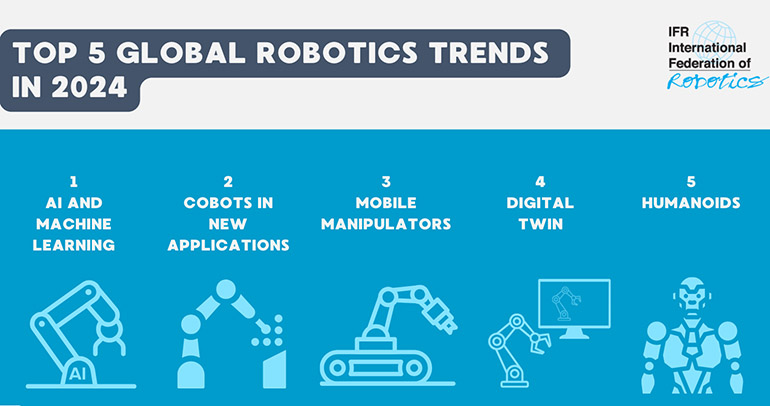|
Listen to this article  |

Source: IFR
The International Federation of Robotics, or IFR, today listed its picks for the top five global robotics trends of this year. The Frankfurt, Germany-based organization attributed growing demand for automation to technological innovations.
The IFR noted that the stock of operational robots around the world attained a new record of about 3.9 million units in 2022. The average robot density, or number of robots per 10,000 human workers, rose to 151. In its latest release, the federation cited some different trends than it had for 2022 and 2023.
1. AI and machine learning to aid more robots
The trend of using artificial intelligence in robotics and automation keeps growing, according to the IFR.
In particular, the emergence of generative AI opens new possibilities, it said. This subset of AI is specialized to create something new from things it has learned via training, and generative AI has been popularized by tools such as ChatGPT, explained the IFR.
Robot manufacturers have started to develop generative AI-driven interfaces that allow users to program systems more intuitively by using natural language instead of code. Workers will no longer need specialized programming skills to select and adjust the robot´s actions, predict experts.
Another example of the combination of technologies is the use of predictive AI to analyze robot performance data and identify the future state of equipment, said the IFR. Predictive maintenance can save manufacturers machine downtime costs.
In the automotive parts industry, each hour of unplanned downtime is estimated to cost $1.3 million (U.S.), reported the Information Technology & Innovation Foundation. This indicates the cost-saving potential of predictive maintenance.
Machine learning algorithms can also analyze data from multiple robots performing the same process for optimization. In general, the more data a machine learning algorithm is given, the better it performs, said the IFR.
 Learn from Agility Robotics, Amazon, Disney, Teradyne and many more.
Learn from Agility Robotics, Amazon, Disney, Teradyne and many more.
2. Cobots expand to new applications, says IFR
Human-robot collaboration continues to be a major trend in robotics, stated the IFR. Rapid advances in sensors, vision technologies, and smart grippers allow robots to respond to changes in their environment in real time and thus work safely alongside human workers.
Collaborative robot applications offer a new tool for human workers, relieving and supporting them. Cobots can assist with tasks that require heavy lifting, repetitive motion, or work in dangerous environments.
The range of collaborative applications offered by robot manufacturers continues to expand. A recent market development is the increase of cobot welding applications, driven by a shortage of skilled welders.
“This demand shows that automation is not causing a labor shortage but rather offers a means to solve it,” said the IFR. “Collaborative robots will therefore complement – not replace – investments in traditional industrial robots, which operate at much faster speeds and will therefore remain important for improving productivity in response to tight product margins.”
In addition, the IFR noted that new competitors are entering the market with a specific focus on collaborative robots. The combination of cobot arms and autonomous mobile robots (AMRs) in mobile manipulators offers new use cases that could expand the demand for collaborative robots, it said.
3. Mobile manipulators to automate materials handling
Mobile manipulators — so-called “MoMas” — can automate material handling tasks in industries such as automotive, logistics, or aerospace, said the IFR. They combine the mobility of mobile robots with the dexterity of cobot arms. This enables them to navigate through complex environments and manipulate objects, which the IFR said is crucial for manufacturing applications.
Equipped with sensors and cameras, these robots can perform inspections and carry out maintenance tasks on machinery and equipment. One advantage of mobile manipulators is their ability to collaborate and support human workers. Shortages of skilled labor and a lack of staffers applying for factory jobs are likely to increase demand, the IFR asserted.
4. Digital twins to help optimize performance
Digital twin technology is increasingly used as a tool to optimize the performance of a physical system by creating a virtual replica, said the IFR. Since robots are more and more digitally integrated in factories, digital twins can use their real-world operational data to run simulations and predict likely outcomes.
Because the twin exists purely as a computer model, it can be stress-tested and modified with no safety implications while saving costs, the IFR said. All experimentation can be checked before the physical world itself is touched. Digital twins can bridge the gap between simulated and physical worlds.
5. IFR expects humanoid robots to march onward
“Robotics is witnessing significant advancements in humanoids, designed to perform a wide range of tasks in various environments,” said the IFR.
The human-like design with two arms and two legs allows such robots to be used flexibly in environments that were built for humans, said the organization and industry observers. As a result, companies might integrate humanoids more easily into existing infrastructure and facilities such as warehouses.
Editor’s note: Jonathan Hurst, co-founder and chief robot officer of Agility Robotics, will keynote the Robotics Summit & Expo, which runs May 1 and 2 in Boston.
Credit: Source link


Comments are closed.